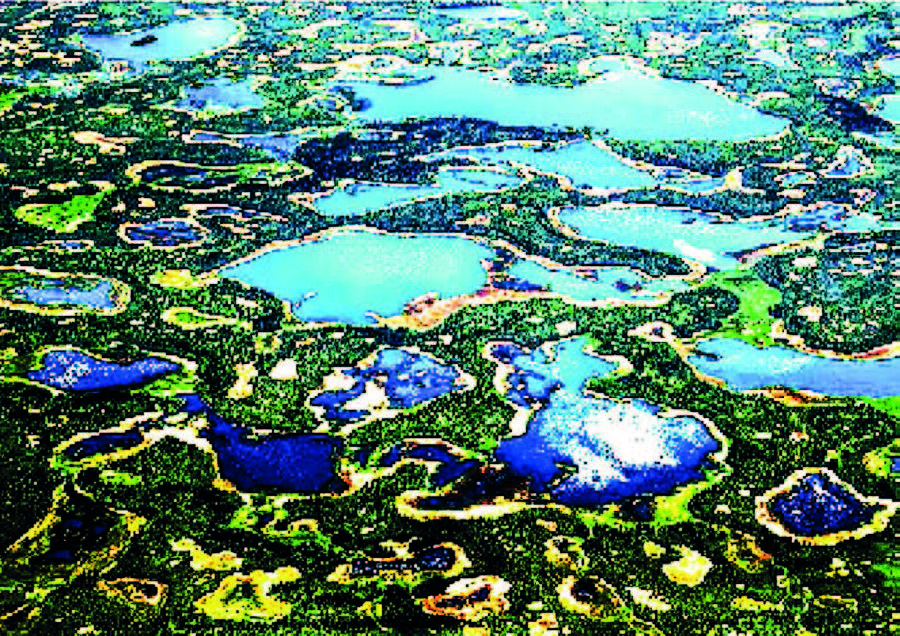By Yin Nwe Ko
AS the world continues to warm, previously overlooked sources of greenhouse gas emissions become significant concerns for scientists and policymakers. One such source is the sediment at the bottom of Arctic lakes, where permafrost thaw is accelerating at far deeper levels than earlier anticipated. The consequences of this thaw could be profound, contributing large quantities of methane and carbon dioxide to the atmosphere and exacerbating the global climate crisis.
The Ancient Landscape of Arctic Permafrost
Arctic permafrost has been a defining feature of the Earth’s northernmost regions for hundreds of thousands of years. This frozen soil layer, which remains below 0°C throughout the year, acts as a massive carbon sink, trapping plant material and greenhouse gases. The formation of permafrost and the development of thermokarst lakes are part of a dynamic landscape shaped by geological and climatic processes over millennia.
Thermokarst lakes are formed when ice-rich permafrost thaws, creating depressions that fill with meltwater. These lakes are ubiquitous across the Arctic and vary widely in size and age, some being several hundred years old. As global temperatures rise, the prevalence and expansion of thermokarst lakes are projected to increase, enhancing interactions between water bodies and the underlying permafrost.
Unveiling the Hidden Threat of Deep Permafrost
Recent studies have shifted attention to the deeper realms of Arctic permafrost, uncovering significant new threats. Traditional climate models predominantly account for the thawing within the top three metres of permafrost. However, deep permafrost layers – extending beyond this superficial depth – remain underexplored.
Nancy Freitas and her colleagues at the University of California, Berkeley, set out to bridge this knowledge gap. Their research, focusing on Alaska’s Goldstream Lake sediments, reveals that microbial activity is well underway in deeper, unfrozen sediment cores as far down as 20 meters below the lake bed. This finding is alarming, as it suggests ongoing greenhouse gas emissions from depths previously thought to be inert.
The team scrutinized sediment cores by exposing them to varying temperatures, ranging from 4°C to 20°C. They found a marked increase in greenhouse gas emissions, indicating that as permafrost warms, substantial quantities of carbon dioxide and methane — an incredibly potent greenhouse gas — will be released.
Current Environmental Trends and Impacts
The Arctic is warming at an unprecedented rate, with temperatures increasing more than twice the global average. This phenomenon, known as Arctic amplification, is driving widespread thawing of permafrost landscapes, including both surface and deeper layers. The thawing permafrost not only leads to the release of trapped greenhouse gases but also triggers ground subsidence, infrastructure damage, and changes in hydrology.
The formation and expansion of thermokarst lakes accelerate these processes. Water in thermokarst lakes transmits heat to the underlying permafrost, intensifying the thawing of deep sediments. This is particularly concerning in light of the high organic carbon content found in these deeper layers. Once thawed, microbial decomposition of ancient organic matter becomes a significant source of methane and carbon dioxide emissions.
Additionally, the impact of these emissions is not confined to the Arctic. The release of greenhouse gases from Arctic lakes contributes to the global atmospheric pool, influencing climate patterns worldwide. This adds to the already complex network of climate feedback mechanisms, making it more challenging to predict and mitigate future climate change impacts.
Future Implications and the Need for Enhanced Research
The revelations from Freitas and her colleagues highlight the urgent necessity for further research into deep permafrost sediments. As current climate models largely overlook these deeper emissions, there is a risk of underestimating the Arctic’s contribution to global greenhouse gas levels.
Addressing this gap is crucial for developing more accurate climate models and devising effective mitigation strategies. By better understanding the processes at play, scientists can improve predictions of future climatic shifts and implement measures to reduce greenhouse gas emissions from thawing permafrost.
One potential avenue of research is the quantification of methane emissions under varying environmental conditions. Given methane’s higher potency as a greenhouse gas compared to carbon dioxide, understanding its production and release from deep permafrost is essential for global climate mitigation efforts.
Furthermore, the findings emphasize the interconnected nature of Earth’s climatic systems. Emissions released in the Arctic do not remain localized; they disperse into the global atmosphere, underscoring the need for international cooperation in addressing this pressing issue.
The thawing of deep permafrost beneath Arctic lakes presents a previously underestimated threat to global climate stability. As temperatures rise and permafrost continues to thaw at greater depths, significant quantities of methane and carbon dioxide are likely to be released, exacerbating the already critical challenge of climate change.
The Imperative for Immediate Measures
The alarming revelations about deep permafrost thaw beneath Arctic lakes underscore the need for a concerted and proactive approach from scientists, policymakers, and global leaders. To avert catastrophic consequences for our climate, it is imperative that we implement immediate and targeted measures.
Deepening Our Understanding
Researchers and scientists play a pivotal role in deepening our understanding of permafrost dynamics and their implications for climate change. It is crucial that scientific communities intensify efforts to study deep permafrost layers and assess the full extent of greenhouse gas emissions from these sources. Enhanced funding for fieldwork, advanced modelling techniques, and collaborative international research initiatives are essential to uncovering the hidden facets of permafrost thaw. By expanding our knowledge base, we can develop more accurate predictive models and devise effective mitigation strategies.
Crafting Robust Policies
Policymakers must recognize the urgency of this issue and craft robust policies aimed at mitigating the release of greenhouse gases from thawing permafrost. This includes integrating findings from the latest scientific research into climate action plans and setting stringent emissions reduction targets. Additionally, investing in sustainable infrastructure and adaptive measures in Arctic regions can help minimize the impact of permafrost thaw on local communities and ecosystems. Policymakers should also advocate for international cooperation to address this global challenge, ensuring that efforts to combat climate change are both comprehensive and inclusive.
Driving Collective Action
Global leaders have a paramount responsibility to drive collective action against the permafrost thaw crisis. This entails fostering international collaboration and committing to ambitious climate goals in forums such as the United Nations Framework Convention on Climate Change (UNFCCC). By aligning efforts and sharing resources, nations can strengthen their resilience to climate change and support vulnerable Arctic communities. Moreover, global leaders must prioritize funding for research and development, ensuring that innovative technologies and solutions are brought to the forefront of the fight against permafrost thaw.
Building Resilience
Local communities in Arctic regions are on the front lines of permafrost thaw impacts. It is vital that they are empowered with the knowledge and resources to adapt to changing conditions. Community-driven initiatives, supported by government and non-government organizations, can facilitate the development of sustainable practices and infrastructure. By actively participating in monitoring programs and leveraging traditional knowledge, local communities can play a crucial role in mitigating the adverse effects of permafrost thaw and safeguarding their unique environments.
A United Front
The challenge posed by deep permafrost thaw beneath Arctic lakes is formidable, but not insurmountable. Through the combined efforts of scientists, policymakers, global leaders, and local communities, we can mitigate the worst impacts and protect our planet for future generations. Immediate action is essential to address this pressing issue, and by working together, we can ensure a sustainable and resilient future in the face of climate change.
While the current findings shed light on these hidden emissions, they also call for further research to fully grasp the extent of this feedback mechanism. By enhancing our understanding of deep permafrost processes, we can develop more accurate predictive models and implement strategies to mitigate the impact on our planet’s climate.
The journey to understanding and mitigating the effects of permafrost thaw is far from over, but with continued research and global cooperation, there is hope for managing this complex and formidable challenge.
Reference: New Scientist


